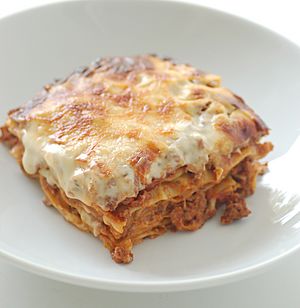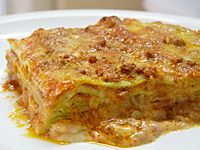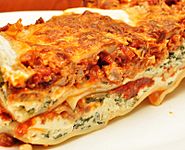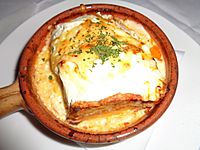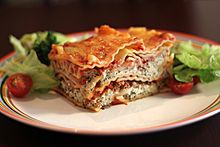Lasagne facts for kids
|
Baked meat lasagne
|
|
| Type | Pasta |
|---|---|
| Course | Primo or main |
| Place of origin | Italy |
| Region or state | Campania, Emilia-Romagna |
| Serving temperature | Hot |
| Main ingredients | Durum wheat |
| Variations | Lasagnette |
Lasagne (sometimes called lasagna in the singular) is a type of wide, flat pasta. It is one of the oldest kinds of pasta. The word lasagne also refers to a yummy dish. This dish is made by stacking layers of pasta with different sauces and ingredients. These can include meats, vegetables, and cheese. Often, it's topped with melted grated cheese. After putting all the layers together, the lasagne is baked in an oven. The baked dish is then cut into square pieces for everyone to enjoy.
Contents
The Story of Lasagne
Lasagne first appeared in Italy a very long time ago. This was during the Middle Ages. Many people believe it started in the city of Naples. The very first recipe was written down in the early 1300s. It was in a book called Liber de Coquina (which means The Book of Cookery).
This early lasagne was a bit different from what we eat today. It used a thin sheet of dough that was boiled. Then, it was sprinkled with cheese and spices. People would eat it with a small pointed stick. Later recipes suggested boiling the pasta in chicken broth. They would then add cheese and chicken fat. For special fasting days, walnuts were sometimes used instead.
The traditional lasagne from Naples is called lasagne di carnevale. It has layers of local sausage and small fried meatballs. It also includes hard-boiled eggs, ricotta cheese, and mozzarella. A special meat sauce called Neapolitan ragù is used.
Another popular type is lasagne al forno. This one uses a thicker meat sauce (ragù) and a creamy Béchamel sauce. This is the version most people know outside Italy. It comes from the Emilia-Romagna region of Italy.
In other parts of Italy, lasagne can be made with many different things. These include ricotta or mozzarella cheese, tomato sauce, and meats like ground beef or chicken. Vegetables like spinach, zucchini, and mushrooms are also common. The dish is often flavored with wine, garlic, onion, and oregano. No matter the ingredients, lasagne is always baked in the oven.
Traditionally, pasta dough in Southern Italy was made with semolina and water. In Northern Italy, where semolina was not common, flour and eggs were used. Today, most store-bought lasagne in Italy is made from durum wheat semolina.
In the northern Italian region of Emilia-Romagna, especially in Bologna, lasagne layers are often green. This color comes from mixing spinach or other vegetables into the dough. This green lasagne is usually served with a thick meat sauce called ragù. It also has bechamel and Parmigiano-Reggiano cheese.
Where Did the Name "Lasagne" Come From?
The word "lasagne" has a long history. In Ancient Rome, there was a dish called lasana or lasanum. This Latin word meant 'container' or 'pot'. This dish was similar to lasagne.
One idea is that lasagne comes from the Greek word laganon. This was a flat sheet of pasta dough cut into strips. Even today, the Greek word lagana means a flat, thin type of bread.
Another idea is that the word comes from the Greek word lasana. This meant a 'trivet' or 'stand for a pot'. The Romans borrowed this word as lasanum, meaning 'cooking pot'. Italians then used this word to talk about the cooking pot where lasagne was made. Later, the food itself took the name of the dish it was cooked in.
There was also an English dish in the 1300s called loseyn. This dish was described in a cookbook called The Forme of Cury. It was made by the cooks of King Richard II. This dish was similar to modern lasagne because it had layers of ingredients between pasta sheets. However, it did not have tomatoes. Tomatoes only came to Europe after Columbus reached America in 1492. The first time tomatoes were written about in Europe was in 1544. The first cookbook with tomato recipes was published in Naples in 1692.
Like many other types of pasta, the Italian word lasagne is plural. It means more than one sheet of lasagna. But in many other languages, people use a word like lasagna (singular) for the baked dish. In Italy, people in the north usually say lasagne for the baked dish. People in the south often say lasagna. This is why in British English you often see "lasagne," and in American English you often see "lasagna."
Gallery
Images for kids
-
Vegetarian lasagne made with tomato sauce, spinach, feta, carrots, mushrooms and grated emmental
See also
 In Spanish: Lasaña para niños
In Spanish: Lasaña para niños


